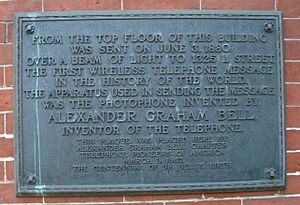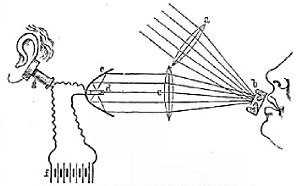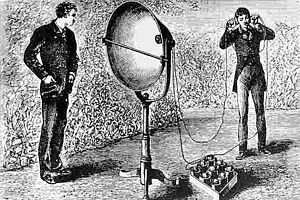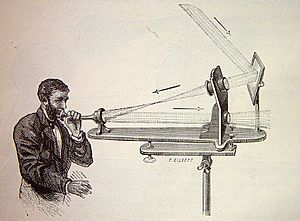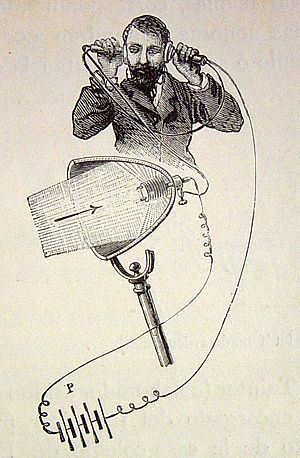Photophone facts for kids
The photophone is a special device that sends speech using a beam of light. It was invented by Alexander Graham Bell and his helper, Charles Sumner Tainter. They created it on February 19, 1880, in Bell's lab in Washington, D.C. Both men later worked together at the Volta Laboratory, which Bell started.
On June 3, 1880, Bell's assistant sent a voice message without wires. It went from the roof of the Franklin School to Bell's lab window. This was about 213 meters (700 feet) away.
Bell thought the photophone was his most important invention. He even said it was "greater than the telephone." Of the many patents Bell received, four were for the photophone. This invention was an early version of the fiber-optic communication systems we use today. These systems became popular in the 1980s. The main patent for the photophone was given in 1880. This was many years before its ideas were used in real life.
Contents
How the Photophone Worked
The photophone was like the telephones of its time. But it used light beams to send messages without wires. Regular telephones used electricity carried through wires.
Bell explained how the light was changed:
We found that the simplest way to make this work was to use a flat mirror made of flexible material. The speaker's voice would hit the back of this mirror. When someone spoke, the mirror would bend, becoming alternately curved inward and outward. This would make the light scatter and come together again.
So, the brightness of the light beam changed with the sound waves. These sound waves hit the mirror.
At first, the photophone receiver did not use electricity. It used something called the photoacoustic effect. Bell found that many materials could turn light directly into sound. A material called Lampblack worked very well. When Bell used a bright beam of sunlight, a receiver with lampblack made a sound he called "painfully loud."
Later, the photophone receiver used electricity. It had a selenium cell and a curved mirror. The selenium cell's electrical resistance changed with the light. It had higher resistance in dim light and lower resistance in bright light. This cell worked like a carbon microphone in a regular telephone. It changed the electric current. Then, an earphone turned the current back into sound.
In 1880, Bell gave credit to Mr. A.C. Brown for first showing how to send speech with light. This happened in London in 1878.
Because the device used radiant energy (like heat and light), a French scientist named Ernest Mercadier suggested calling it a 'radiophone'. This was because its mirrors reflected many types of light, including invisible infrared light. Bell used this name for a while. But it is not the same as the later "radiophone" which used radio waves.
First Wireless Voice Calls
While on his honeymoon, Bell likely read about selenium. He learned that its electrical resistance changed when light hit it. He thought that if he added a telephone receiver, he could hear what Sabine could only see.
Bell hired Charles Sumner Tainter to work in his new lab in Washington. Tainter was a skilled instrument maker.
On February 19, 1880, Bell and Tainter made a working photophone. They attached metal strips to a thin sheet called a diaphragm. A light beam was blocked by the moving strips as sounds were spoken. When this changed light hit their selenium receiver, Bell could clearly hear Tainter singing Auld Lang Syne through his headphones.
On April 1, 1880, Bell and Tainter talked over 79 meters (260 feet). This was in an alleyway behind the lab. A few months later, on June 21, they talked clearly over 213 meters (700 feet). They used plain sunlight as their light source. Electric lights were still quite new then.
In these later tests, the transmitter used sunlight reflected off a thin mirror. This mirror was at the end of a speaking tube. As words were spoken, the mirror would bend. This changed how much light was reflected to the receiver. Tainter was on the roof of the Franklin School. He spoke to Bell, who was in his lab listening. Bell signaled back by waving his hat.
The receiver had a curved mirror with selenium cells at its center. This test from the Franklin School roof to Bell's lab was the world's first wireless telephone call outside of their lab. This made the photophone the earliest known voice wireless telephone system. It was at least 19 years before the first radio wave transmissions. Bell and Tainter created about 50 different ways to change light beams for optical telephony. They then moved on to develop the Graphophone.
Later Improvements
Researchers at Bell Telephone made some small improvements to the photophone. But Marconi's radio transmissions soon went much farther than the photophone. So, work on the photophone slowed down.
German-Austrian scientists started new experiments around 1900. A German physicist named Ernst Ruhmer believed his better selenium cells could make the photophone work over longer distances. From 1901 to 1902, Ruhmer did tests on the Havel river and Lake Wannsee. He said he could send messages up to 15 kilometers (9 miles) away. This worked well both day and night. He continued his tests with the German Navy until 1904. The Navy provided strong searchlights for the transmissions.
The German Siemens & Halske Company also improved the photophone's range. They used carbon arc lamps that changed with the electric current. These lamps could reach about 8 kilometers (5 miles). They sold these units to the German Navy. The Navy made them work up to 11 kilometers (7 miles) using voice-controlled ship searchlights.
During World War I, British researchers developed a new vibrating mirror in 1916. More sensitive molybdenite cells replaced the older selenium cells in 1917. These new cells were better at detecting infrared light. The United States and German governments also worked on improving Bell's system.
By 1935, the German Carl Zeiss Company made infrared photophones for the German Army's tanks. These used tungsten lamps with infrared filters. The light was changed by vibrating mirrors or prisms. They also used receivers with lead sulfide detectors and amplifiers. This boosted their range to 14 kilometers (9 miles) in good conditions. The Japanese and Italian armies also tried to develop similar lightwave communication before 1945.
Some military labs, including those in the United States, kept working on the photophone into the 1950s. They experimented with powerful vapor and mercury arc lamps.
Remembering the Photophone
FROM THE TOP FLOOR OF THIS BUILDING
WAS SENT ON JUNE 3, 1880
OVER A BEAM OF LIGHT TO 1325 'L' STREET
THE FIRST WIRELESS TELEPHONE MESSAGE
IN THE HISTORY OF THE WORLD.
THE APPARATUS USED IN SENDING THE MESSAGE
WAS THE PHOTOPHONE INVENTED BY
ALEXANDER GRAHAM BELL
INVENTOR OF THE TELEPHONE
THIS PLAQUE WAS PLACED HERE BY
ALEXANDER GRAHAM BELL CHAPTER
TELEPHONE PIONEERS OF AMERICA
MARCH 3, 1947
THE CENTENNIAL OF DR. BELL'S BIRTH
On March 3, 1947, which was 100 years after Alexander Graham Bell was born, a historical marker was placed. It was put on the side of the Franklin School. This was where Bell and Sumner Tainter did their first long-distance test. Tainter stood on the school roof and sent a message to Bell in his lab. The marker did not mention Tainter's important work.
On February 19, 1980, exactly 100 years after their first photophone message, people gathered. Staff from the Smithsonian Institution, the National Geographic Society, and AT&T's Bell Labs met at Bell's old lab in Washington, D.C. They were there to remember the event.
The idea for the Photophone Centenary came from electronics writer Forrest M. Mims. He suggested it to Dr. Melville Bell Grosvenor, Bell's grandson. At the event, they used a photophone that Mims had built. It worked much like Bell and Tainter's original model.
Mims also made two modern, battery-powered LED transceivers. These were connected by 100 meters (100 yards) of optical fiber. Richard Gundlach from Bell Labs and Elliot Sivowitch from the Smithsonian used this device. They showed how the photophone's ideas are used today. The National Geographic Society also had a special exhibit. It showed the photophone's invention with original items from the Smithsonian.
See also
- Atomic line filter
- Free-space optical communication
- History of telecommunication
- Laser microphone
- Mie scattering
- Modulating retro-reflector
- Optical sound
- Optical window
- Photoacoustic effect
- Radio window
- Rayleigh scattering
- Semaphore line
- Visible light communication
- Volta Laboratory and Bureau


